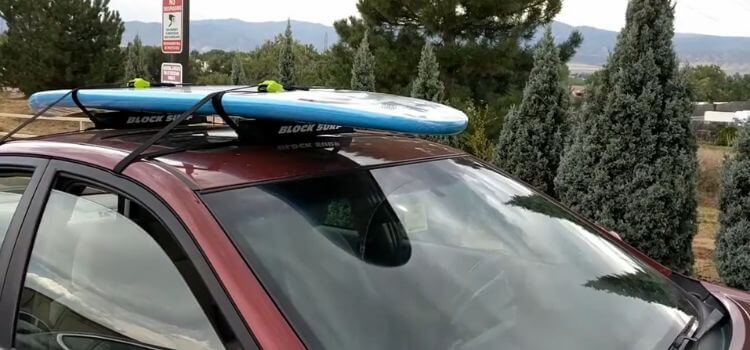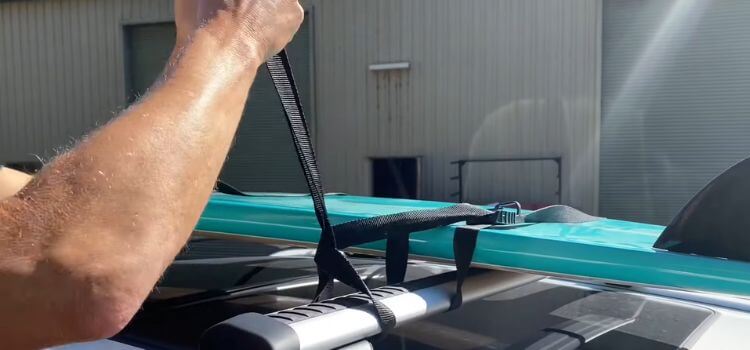As an Amazon Associate, I earn from qualifying purchases
To strap a surfboard to a roof rack, pass a fastening strap over the surfboard across the car and then pass it through the bottom of the roof rack. Throw the fastening strap over the surfboard again and under the roof rack, joining both ends tightly to secure the board without damaging its edges.
Options For Strapping Surfboard To Roof Rack

Securely strapping your surfboard to a roof rack is essential for safe transportation. Pass a fastening strap over the surfboard, through the bottom of the roof rack, and then back over the surfboard, ensuring a tight but not damaging hold.
Surfboard Tie Down Straps
When it comes to strapping your surfboard to a roof rack, one of the most popular options is to use surfboard tie down straps. These straps are specifically designed for securing surfboards and provide a secure and reliable method of transportation.
To use surfboard tie down straps, start by placing your surfboard on the roof rack. Make sure the board is centered and facing fins up. Then, take one end of the strap and pass it under the roof rack bars, bringing it up and over the board. Next, feed the end of the strap through the buckle and pull it tight. Repeat this process for the other end of the board.
It’s important to ensure that the straps are tight enough to secure the surfboard, but not too tight to damage the board. Double-check the straps before hitting the road to make sure your board is secure and ready for transport.
Soft Roof Rack Pads
If you’re looking for a more cushioned option to protect your surfboard during transportation, soft roof rack pads are a great choice. These pads provide an extra layer of padding between your board and the roof rack, preventing any potential damage.
To use soft roof rack pads, start by placing the pads on the roof rack bars. Make sure they are centered and evenly spaced. Then, place your surfboard on top of the pads, aligning it with the rack bars. Finally, secure the board using surfboard tie down straps or other securing methods.
Soft roof rack pads are a versatile option that can be used with a variety of roof rack types. They offer added protection for your surfboard and ensure a safe and secure journey to your next surf spot.
Roof Rack Straps
In addition to surfboard tie down straps and soft roof rack pads, another option for strapping your surfboard to a roof rack is to use roof rack straps. These straps are specifically designed for securing items to roof racks and offer a reliable and sturdy method of transportation.
To use roof rack straps, start by placing your surfboard on the roof rack. Then, pass the strap over the board and under the roof rack bars. Pull the strap tight and secure it using the buckle or fastening mechanism provided.
Roof rack straps are known for their durability and strength, making them a popular choice among surfers. They provide a secure and stable method of transportation, ensuring your surfboard stays in place even during long road trips or bumpy rides.
With options such as surfboard tie down straps, soft roof rack pads, and roof rack straps, you can choose the method that suits your needs and preferences. Remember to always double-check the security of your surfboard before hitting the road, and enjoy a worry-free journey to your favorite surf spot.
Step-by-step Guide To Strapping Surfboard To Roof Rack

Strapping your surfboard securely to a roof rack is crucial for a safe and hassle-free journey to the beach. With the right technique and equipment, you can confidently transport your surfboard without worrying about it shifting or getting damaged along the way. In this step-by-step guide, we will walk you through the process of strapping your surfboard to a roof rack, ensuring that you follow all the necessary precautions to keep your board safe and secure.
Preparing The Surfboard And Roof Rack
Before you begin strapping your surfboard to the roof rack, it is essential to prepare both your board and the rack properly. Follow these steps to ensure a solid foundation for the strapping process:
- Inspect your surfboard: Check your surfboard for any existing damages, such as dings or cracks. Repair them if necessary, as strapping your board to the rack can put additional stress on its structure.
- Clean your surfboard: Give your surfboard a thorough rinse to remove any dirt or sand. This will help prevent scratches and unnecessary wear and tear during transport.
- Position the roof rack: Place the roof rack on the roof of your vehicle, ensuring that it is properly aligned and securely fastened according to the manufacturer’s instructions.
Securing The Surfboard With Tie Down Straps
Once you have prepared your surfboard and roof rack, it’s time to secure your board using tie down straps. Follow these steps to ensure a tight and secure fit:
- Place the surfboard on the roof rack: Gently lift your surfboard and position it on the roof rack, making sure it is centered and parallel to the vehicle.
- Loop the straps around the roof rack: Take the tie down straps and loop them around the roof rack’s crossbars, ensuring that they are evenly spaced and secure.
- Thread the straps through the buckle: Pull one end of each strap through the buckle, creating a loop to secure the surfboard. Make sure the buckles are facing upwards for easy adjustment.
- Lay the surfboard on the straps: Carefully lay the surfboard on the straps, positioning it in the center of the roof rack.
- Secure the straps around the surfboard: Pull the loose ends of the straps tight, cinching them around the surfboard. Make sure the straps are snug and secure, but not overly tight, to avoid damaging the board.
Ensuring The Surfboard Is Secure
Once you have secured the surfboard with tie down straps, it’s crucial to double-check its stability before hitting the road. Follow these final steps to ensure your surfboard is securely fastened:
- Test the stability: Give the surfboard a gentle shake to verify that it is securely held in place. If it moves excessively, readjust the straps and tighten them further.
- Inspect the straps: Check the tie down straps for any signs of looseness or slippage. If necessary, tighten them further or add additional straps for extra security.
- Drive with caution: When driving with a surfboard on your roof rack, keep in mind that your vehicle’s center of gravity has changed. Adjust your driving habits accordingly and avoid sudden maneuvers or high speeds.
By following this step-by-step guide, you can confidently strap your surfboard to a roof rack and enjoy a worry-free journey to your favorite surf spot. Remember to regularly check the straps while driving to ensure the surfboard remains secure throughout your trip.
Additional Tips And Techniques

Securing your surfboard to a roof rack is essential for a safe journey to the beach. In addition to the basic steps, there are a few extra tips and techniques that can make the process even more secure and convenient. Below, we’ll explore two additional methods for securing surfboards and provide some helpful advice for driving with a strapped surfboard.
Using Cinch Straps For Easy Tightening
Cinch straps are an excellent tool for tightening your surfboard securely to the roof rack. These straps have a ratchet mechanism that allows you to easily tighten and lock the strap in place. Follow these steps to use cinch straps:
- Place the surfboard on the roof rack, positioning it in the desired location.
- Thread the cinch strap through the roof rack bars closest to the surfboard.
- Pull the strap tightly until it is snug against the surfboard.
- Engage the ratchet mechanism by moving the handle back and forth until the strap is securely tightened.
- Double-check the tightness of the strap to ensure it is secure.
The cinch straps provide a reliable and user-friendly method for securing your surfboard to the roof rack. Their ability to tighten easily and lock securely gives you peace of mind during your journey.
Alternative Methods For Securing Surfboards
While using tie-down straps is the most common method for securing surfboards to a roof rack, there are a few alternative methods worth considering:
- Bungee cords: Bungee cords can be used as an alternative to tie-down straps. They provide a quick and easy solution for securing your surfboard, but keep in mind that they may not offer the same level of security and stability as dedicated tie-down straps.
- Surfboard pads: Surfboard pads are foam cushions that wrap around the surfboard and provide additional protection. These pads can be used in conjunction with tie-down straps to secure the surfboard to the roof rack and prevent any damage.
- Locking systems: If you’re concerned about theft, consider investing in a locking system specifically designed for surfboards. These systems provide an extra layer of security by preventing unauthorized removal of your surfboard from the roof rack.
By exploring these alternative methods, you can find the one that best suits your needs and preferences.
Driving With A Strapped Surfboard
Driving with a strapped surfboard on your roof rack requires some extra caution to ensure a safe and smooth journey. Follow these tips to drive confidently:
- Reduce speed: Drive at a moderate speed and avoid sudden maneuvers to minimize the impact of wind resistance on your surfboard.
- Regularly check the straps: During your journey, periodically check the tightness of the straps to ensure they haven’t come loose.
- Monitor the surfboard: Use rearview mirrors to keep an eye on the surfboard and ensure it remains securely in place.
- Choose sturdy roof racks: Invest in high-quality roof racks that can handle the weight and securely hold your surfboard.
- Plan your route: Avoid routes with low-clearance areas or obstacles that could potentially damage your surfboard.
By following these driving tips, you can have a worry-free journey and arrive at your destination with your surfboard in perfect condition.
Frequently Asked Questions For How To Strap Surfboard To Roof Rack
How Do You Secure A Surfboard On A Roof Rack?
To secure a surfboard on a roof rack, pass a fastening strap over the surfboard across the car and through the bottom of the roof rack. Then, throw the strap over the surfboard again and under the roof rack. Join both ends of the strap tightly but not too tight to avoid damaging the edges of the surfboard.
How Do You Secure A Board To A Roof Rack?
To secure a board to a roof rack, pass a fastening strap over the surfboard across the car and through the bottom of the roof rack. Then, throw the strap over the surfboard again and under the roof rack. Tighten the strap, ensuring it’s secure but not too tight to avoid damaging the surfboard’s edges.
How Do You Travel With A Surfboard On A Car?
To travel with a surfboard on a car, pass a fastening strap over the surfboard across the car. Pass it through the bottom of the roof rack and then throw the strap over the surfboard again, under the roof rack.
Join both ends of the strap tightly but not too tight to avoid damaging the surfboard edges.
How Do You Strap Gear To A Roof Rack?
To strap gear to a roof rack, pass a fastening strap over the gear and through the bottom of the roof rack. Then, throw the strap over the gear again and under the roof rack. Tighten both ends of the strap securely but not too tight to avoid damaging the gear.
Conclusion
Securing your surfboard to a roof rack is essential for a safe and hassle-free journey to the beach. By following the steps outlined in this blog post, you can ensure that your surfboard remains secure and protected during transportation. Remember to use high-quality straps, pass them over and under the surfboard, and tighten them enough to secure the board without causing damage.
Now you can confidently hit the road and catch those waves without worrying about your surfboard. Happy surfing!
Read More
1. How to Hang a Surfboard on a Wall
4. What are Surfboards Made of
As an Amazon Associate, I earn from qualifying purchases

